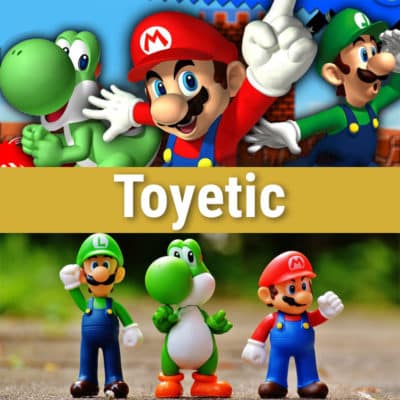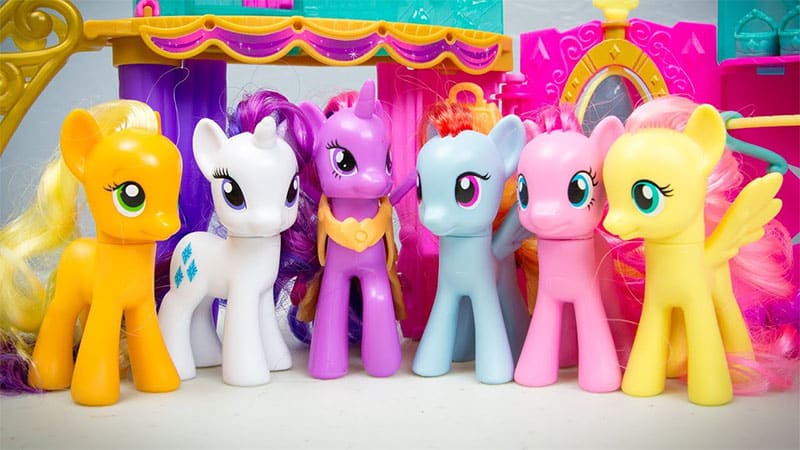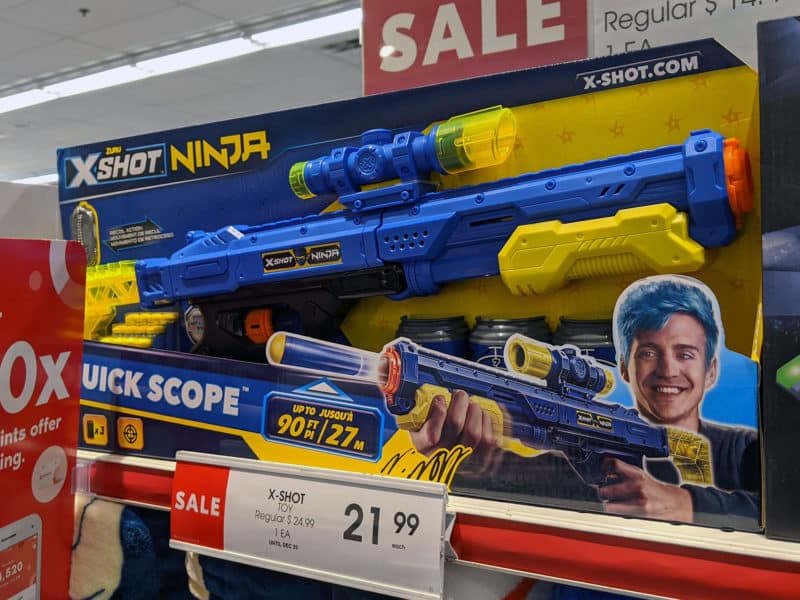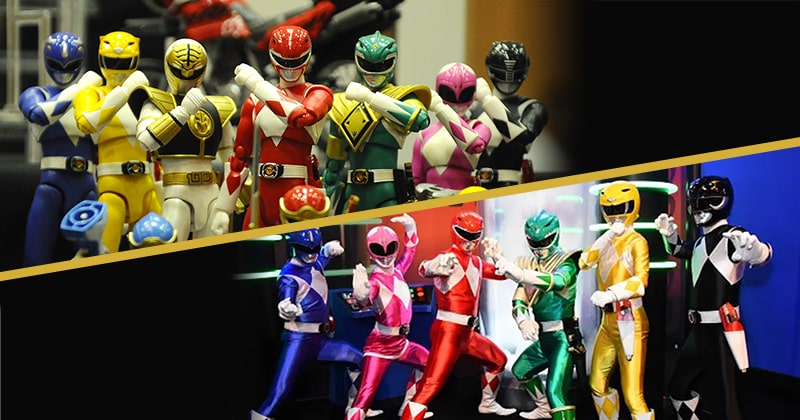The Mighty Morphin Power Rangers characters and Zords were very toyetic. The characters could be made into action figures, and the Zords could be made into transformable vehicles, all of which kids wanted to play with.

A toyetic character or object is one that could easily be made into a marketable toy.
If you are in the toy or children’s media industries, then you may have heard the word “toyetic” thrown around. But do you truly know what it means? It is a necessary term when discussing the future of media properties.
Toyetic describes how suitable a character or object from a movie, cartoon or book is to be made into a toy.
Main characters, pets, tools or vehicles may have a shape and features that lend well to plastic moulding and decoration, while others may not. For example, the Mario we know and love from Super Mario 64 onward has a rounded form (easy to mould) with large features (easy to paint or apply decals.)
Also, the nature of the characters or the function of the objects may make them more (or less) desirable for kids to play with. For example, the characters in the world of Pokemon participate in a game on the show and the video games, and kids want to play that game in real life.
I am fascinated with children’s media properties such as Power Rangers, Teenage Mutant Ninja Turtles or Paw Patrol. Successful cartoons, movies, video games, and now creators can put their logo or image on nearly anything, and that product will sell when it wouldn’t have sold before.
This ability is unique to media brands. If a traditional brand overextends itself and puts its logo on products that do not make sense, then the brand is diluted and becomes less meaningful.
BMB reviews examples of this in both our article 11 Brand Extension Examples and What is Brand Dilution? Reading those articles will help you understand why media is different.
There is no such limit for children’s media brands. For example, I worked with a company that manufactured small metal shovels for children. They put in hardware stores and sell a few. They developed a way to apply an image to the shovel’s blade durably, licensed some media properties (Disney’s Frozen and Pixar’s Cars, I believe), but the characters on and these shovels would fly off the shelves.
If you’re also interested in the toy industry, you might enjoy “The Toys That Made Us” documentary series on Netflix.
Definition of Toyetic
Toyetic refers to a media property’s potential to inspire marketable toys and games.
A highly toyetic media property would have characters, tools, vehicles and environments that could a) be reasonably replicable as a toy and b) get kids inspired to play with them. For example, My Little Pony: Friendship is Magic has simply designed characters easily adapted as plastic toys. The shows have scenarios that inspire children to play out and imagine using toys.

The characters and objects featured property that is not very toyetic would be hard or expensive for toy designed and manufacturers to make into toys. And if they were able to, kids may not want to play with them. For example, Disney-Pixar’s Luca is a great movie, but it is hard to make figures that convert into sea monsters, and, even if they could, the plot isn’t one that kids want to act out or expand upon. Contrast that to Disney-Pixar’s Cars franchise, which is endlessly merchandisable.
Toyetic in a Sentence
“I am sure it is a great story that would translate well on-screen; it’s just not very toyetic.”
Synonyms of Toyetic
- Toy-like Quality
- Merchandisable
- Toy-worthy
Where did the term ‘toyetic’ come from?
A toy company executive told Steven Spielberg that the characters and vehicles from ‘Close Encounter of the Third Kind’ were not “toyetic.”
In the 60s and 70s in the United States, the FCC had rules that considered media staring characters from toy lines to be advertisements, not television shows. Toy companies were limited in the use of characters and vehicles in toys. Toys could be based on shows, but shows could not be based on existing toy lines.
Meanwhile, movies (not based under the jurisdiction of the FCC) were sources of toys that kids were desperate to play with. Star Wars (1977) spawned a wildly successful toy line that took Kenner from a minor player to one of the major toy companies in the world.
After the rules changed, toy companies ushered the era of cartoons featuring toys in. The 1980s airwaves were dominated by shows like GI Joe, Transformers, My Little Pony, and others. Kids loved shows because they featured their toys, and they love the toys because they were in their favorite shows.
Toyetic became an essential concept for children’s shows and movies because a large part of the revenue from a media property was from its toy licenses. Highly toyetic media made more money than one that was not, so executives greenlighted productions based on the toy-like nature of the characters, tools, settings and vehicles.
Bernard Loomis met with Stephen Spielberg to preview the movie “Close Encounters of a Third Kind.” Spielberg knew Loomis was working with his friend George Lucas to develop toys for Star Wars, and Spielberg wanted a similar treatment for his film.
But Stephen Spielberg’s movie wasn’t appropriate for children, and film-makers designed the spaceships and characters in a way no kid would be interested in playing with. Benard Loomis told Stephen Spielberg that the characters and spaceships from Close Encounters of the Third Kind were not toyetic.
Bernard Loomis Coined the term ‘Toyetic.’
The executives in the toy and media industries needed a phrase to discuss how monetizable a media property was from toys; Loomis said ‘toyetic.’
Bernard Loomis was a toy developer, marketer and executive prominent in the toy industry from the 60s to the 90s.
He was best known for developing the toy line for Star Wars. The toys from the original movie sold over $100 million worth of toys and $3 billion in total over 35 years.
Loomis was also known for leveraging broadcast media to launch iconic brands such as Strawberry Shortcake, Care Bears, and Hot Wheels. Loomis was partially responsible for the era in the late eighties to nineties where they were a lot of new children’s media where kids had as much time watching the shows and movies as playing with the toys. It was a genuine synergy (of fun.)
If you are interested in Hot Wheel, check out our article on the Hot Wheels ID sub-brand. Mattel’s effort to blend the line between physical play and digital play will determine if Hot Wheels continues to be relevant.
Examples of Toyetic
Some media is bursting with toy ideas and play scenarios, while others are not.
Media that is highly toyetic:
- Star Wars
- Mighty Morphin Power Rangers
- My Little Pony: Friendship is Magic
- Pixar’s Cars
- GI Joe
- Transformers
- Toy Story
- LEGO Bionicle
- Paw Patrol
- Rainbow Brite
- Space Jame
- Minecraft
Media that is not toyetic:
- Rayman
- Boss Baby
- Wizard of Oz
- The Nightmare Before Christmas
- That’s So Raven
- The Princess Bride
- A Series of Unfortunate Events
- Fantasia
- The Fantastic Mr Fox
- Magic The Gathering
- Willy Wonka and the Chocolate Factory
Modern children’s media.
Some new media and streaming media properties are highly toyetic, while others are not. Is the toyetic era over?
Media is a little different for kids nowadays. Previously, the channels kids watched media on were cable television, video and (later) video games. Kids had to watch what was on cable, in theatres or on VHS at the time; media executives had as much influence on what kids watched as much as the children themselves. This narrow bandwidth for children’s media meant that most kids on the playground watched the same shows and movies and thus playing with the same toys.
Now, kids stream media from Netflix, YouTube, and Disney Plus as well as play apps on phones or tablets and even have unique experiences on games such as Minecraft and Roblox. Kids have the choice to watch or play whatever they want at any given moment.
We are just now seeing new media creators come out with toys. One of the top creators on YouTube, Ryan’s Word (previously Ryan’s Toy Review), has a toy line in Walmart because his brand is highly toyetic. Twitch streamer Ninja has licensed his likeness and brand to toys online (like a playable skin in Fortnite) and off (wigs, figures, and toys like the soft shotgun below).

Some new media creators are highly toyetic. Merchandise companies can use the new media creator’s appearance, personal brand and memes in their community and content to make toys or boost existing toys to make them desirable.
Other new media stars, even huge and family-friendly ones like Mr Beast, are not very toyetic. Kids love him, but the nature of his content doesn’t inspire them to run to Toys ‘R Us.
Conclusion
Toyetic helps media and toy industry insiders describe a very tricky but very real concept.
When executives discuss how much to invest and prioritize a media property, they need to consider how much it can make in secondary channels like licensing. It is similar to total-addressable-market (TAM); a property with more significant potential to make money and serve many customers is more worthy of investment. Investors should prioritize a toyetic media property over a non-toyetic property for a business.
Maybe this is cynical, and the concept of toyetic and the push to merchandise has killed off great storytelling. I’ll leave that up to you.
I believe that the shows make the toys more fun, and the toys make the shows more engaging.
But I grew up in the 80s and 90s. You’ll have to pry my Transformers out of my hand.

Leave a Reply